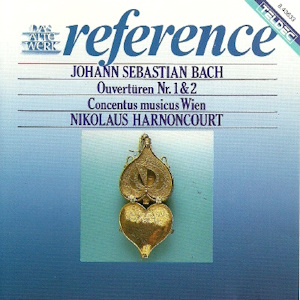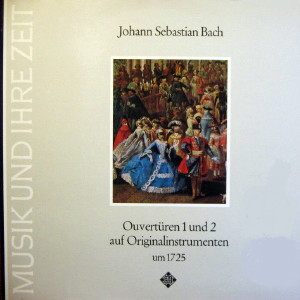 |
| 1 CD -
8.43633 ZS - (c) 1987 |
 |
1 LP -
SAWT 9509-A - (p) 1967
|
|
OUVERTÜREN Nr. 1 & 2 - um 1725
|
|
|
|
|
|
|
|
|
|
| Johann Sebastian BACH
(1685-1750) |
Ouvertüre
(Suite) Nr. 1 C-dur, BWV
1066 |
|
28' 00" |
|
A |
|
für
Oboe I, II; Fagott; Violine I, II;
Viola; Continuo (Violoncello, Violone
[Kontrabaß], Cembalo)
|
|
|
|
|
|
- Ouverture |
10' 57" |
|
1 |
|
|
- Courante |
3' 04" |
|
2 |
|
|
- Gavotte
I alternativement / Gavotte II |
3' 10" |
|
3 |
|
|
- Forlane
|
1' 24" |
|
4 |
|
|
- Menuet
I alternativement / Menuet II |
3' 56" |
|
5 |
|
|
- Bourrée
I alternativement / Bourrée II |
2' 29" |
|
6 |
|
|
- Passepied
I / II |
3' 19" |
|
7 |
|
| Johann Sebastian BACH |
Ouvertüre
(Suite) Nr. 2 h-moll, BWV
1067 |
|
26' 21" |
|
B |
|
für
Flauto traverso; Violine I, II; Viola;
Continuo (Violoncello, Violone
[Kontrabaß], Cembalo) |
|
|
|
|
|
- Ouverture
- Lentement |
12' 22" |
|
8 |
|
|
- Rondeau |
1' 41" |
|
9 |
|
|
- Sarabande |
3' 22" |
|
10 |
|
|
- Bourrée I
alternativement / Bourrée II
|
1' 51" |
|
11 |
|
|
- Polonaise / Double
|
3' 23" |
|
12 |
|
|
- Menuet |
1' 32" |
|
13 |
|
|
- Badinerie
|
1' 28" |
|
14 |
|
|
|
|
|
|
CONCENTUS
MUSICUS WIEN (mit
Originalinstrumenten)
- Leopold Stastny, Flûte
traversière
- Jürg Schaeftlein, Barockoboe
- Karl Gruber, Barockoboe
- Otto Fleischmann, Barockfagott
- Alice Harnoncourt, Violine
- Peter Schoberwalter, Violine
- Stefan Plott, Violine
- Walter
Pfeiffer, Violine
- Josef de
Sordi, Violine
- Kurt Theiner,
Viola
- Nikolaus
Harnoncourt, Violoncello
- Eduard
Hruza, Violone
- Herbert Tachezi,
Cembalo
Nikolaus HARNONCOURT, Leitung
|
|
|
|
|
|
Luogo
e data di registrazione |
|
Casino
Zögernitz, Vienna (Austria) -
December 1966
|
|
|
Registrazione:
live / studio |
|
studio |
|
|
Producer |
|
Wolf
Erichson
|
|
|
Prima Edizione
LP |
|
Telefunken
- SAWT 9509-A - (1 LP) - durata
54' 21" - (p) 1967 - Analogico
|
|
|
Edizione
"Reference" CD
|
|
Tedec
- 8.43633 ZS - (1 CD) - LC 3706 -
durata 54' 21" - (c) 1987 - AAD |
|
|
Cover |
|
Foto mit
freundlicher Genehmigung des
Museums für Kunst und Gewerbe
Hamburg |
|
|
Note |
|
-
|
|
|
|
|
That
such a form creator
as Bach, who fitted
every worlt into a
strict self-made
architectural plan
in which the overall
structure and the
smallest musical
gesture alike had
their place, had to
regard this
"unfarmed" form as a
challenge and
stimulus is
self-understood. The
selection and
sequence of the
movements as a task
for the performer, a
matter of course in
France ten years
earlier and still
quite thinkable
among his
contemporaries, is
out of the question
in his suites. One
cannot amit a single
movement or out it
in a different
place, without
destroying the whole
works. For Bach
differed in one
important respect
from all composers
of his generation:
he rejected the
freedom of the
performer, that
essential feature of
all baroque music
entirely. Perhaps it
was just because he,
as an unequalled
improviser, knew the
dangers that
threatened the best
compositions of his
colleagues through
the arbitrary
interference
self-understood at
that time, such as
choice of
instruments.
transposition,
arrangements of the
order or again
through clumsy
ornarnentation, that
he left no place for
this in his own
works. In this, he
was two generations
ahead of this time.
Just as he wrote out
the execution of the
ornaments in
detail - which
must almost have
been an insult to
the musicians of
that time - he also
laid down himself
the final and
unequivocal form.
Through the
extension of the
dominating
introductory
movement the
overture, to half
the length of the
entire work he
elevated his suites
from the sphere of
light "table rnusic"
and formed them into
genuine works of
"worldly"' festive
music. The elements
of greatness and
splendour are
underlined by the
constitution of the
orchestra in the
1st, 3rd ond 4th
suites The dances
and characteristic
pieces follow the
overture according
to a brilliant plan
of dramatic
significance.
ln the First Suite
in C major, a
beginning is made by
a nostalgic,
song-like courante
in the French
manner. This legato
piece is followed,
as if the reins were
being let looser, by
a gay gavotte (in
which. in accordance
with Muffat's
demands, the second
and fourth crotchet
"should be far more
restrained than
hurried"); this
intensivication
finds its climax in
a wild southern
forlana. Constant
quaver movement in
me middle parts is
here intended to
represent the
excited crowd of
spectators. This
most unbridled and
follt-like of all
Bach's dances is
followed, in rnost
extreme contrast by
a minuet, the court
dance "par
excellence". ln a
self-contained
symmetrical sequence
(a kind of miniature
in itself) -
minuet/bourree/passepied
(a quick variety of
minuet) - the
spirits that have
become so heated by
the farlana are
calmed again. and
mode "fit for the
court" ance more In
addition, the two
last dances
represent a
symmetrical final
reflection of the
first two: courante
(song-like) and
gavotte (refinedly
dance-like) are
corresponded to by
the bourrée and
passepied. These two
dances are closely
related to the first
two, bourrée being
the more lively
sister of the
gavotte and the
passepied, a
peculiar song-like
variety of this
dance form,
recalling the
courante. lt differs
markedly from the
usual pattern, its
expressively legato
quaver figures in
the first section
and even more so in
the Passepied ll (in
the oboe solo)
importing a flowing,
cantabile quality to
the piece. The
hemiole fineness of
the traditional
passepied are
suggested in the
background in this
piece.
ln the second Suite
in B minor. the
intensification of
expression of the
individual dances is
perhaps still more
clearly marked. The
sequence of dances
begins with a
discreetly noble
Rondeau (a gavotte)
ond rises to
powerful expression
in the measured
stnding of the
Sarabande. The
impetuous Bourrée I
and the delicate
Bourrée II bring a
further
intensification,
which finds its goal
in the grandiose and
proud Palonaise. The
latter's "Double" is
at the same time the
virtuoso climax of
the flute solos in
this suite. Again
the classical Minuet
follows an elegant
calming influence.
Since, however, this
suite is truly
speaking a flute
concertino, the
impudent coquettish
Badinerie is tacked
on as a bravura
piece for the flute
- a ready-composed
encore, as it were.
Concertante
Elements in the
Suites
Soloists are already
used un the earliest
overtures and dances
of Lully, preference
being shown for a
trio of two oboes
ond a bossoon that
reply to the tutti
sections played
"forte". The
contrasting of two
dances played in
alternation (such as
two minuets or two
govottes), the
second of which was
allated only to this
solo trio (thus the
later classical
designation "Trio"
for every second
minuet) was also
introduced by Lully.
These solo
possibilities
already prepared
were extended by
Bach in many
directions. There
are predominant solo
instruments in each
of his suites, which
make their main
appearance in the
Allegro section of
the overture thus
lending it a
concertante
character buth are
also heard in the
dances. In the First
Suite it is the two
oboes and the
bossoon, whose
virtuoso passages
even go beyond those
of the First
Brandenburg Concerto
in their technical
demands Their solos
are explicitly
headed "Trio" in the
autograph wind parts
The bassoon, in
particular, was
otherwise given such
difficult and solo
tasks only by
Vivaldi at that
time. Also
concertante are -
apart from the
Overture - Gavotte
ll and Passepied ll,
whereas the Bourrée
II is a genuine wind
trio in the older
sense. ln the Second
Suite the transverse
flute predominates,
which had just risen
to the status of o
highly fashionable
instrument at that
time. "...This
instrument it is
true, has become
very popular,
especially in
Germany, since
thirty to forty
years...", writes
Quantz in 1752. It
here plays solo in
the Overture.
Randeau (Govotte),
Baurrée Il, in the
Double of the
Polonoise and in the
Badinerie.
Nikolaus
Harnoncourt
|
|